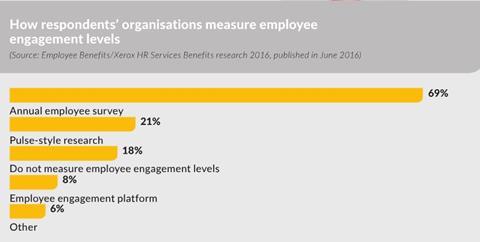
Need to know
- Measuring employee engagement should be an all-employee exercise.
- It can take place once a year through a survey, or be continual, using every opportunity available to gauge employees’ engagement levels.
- Employee benefits can play a key part in a wider engagement strategy.
Employee engagement is highly regarded as a key factor in exemplary individual and organisational performance: it draws on an employer’s culture, values and behaviours, and drives employee motivation and productivity at work.
But engagement can be defined in different ways by different organisations. In addition, just as organisations can differ greatly, what drives an individual can be vastly dissimilar to what motivates their colleagues. Nick Howard, executive director at employee engagement and research business EdelmanEngage, says: “Our definition when we talk about employee engagement is we’re not talking about a process or methodology or a tool, we’re talking about the outcome that organisations are looking for, which is employees doing the things that will add value to their business. We talk about employee engagement in terms of the behaviours that organisations want their employees to be exhibiting every day, because those are the behaviours that create value.”
The ultimate measure of employee engagement is the productivity of a business, says Mark Pemberthy, director at JLT Employee Benefits. “If employees are engaged, then the creativity, the level of output, and the dynamics of the business will ultimately see top- and bottom-line benefits of that,” he adds.
Methods of measurement
Trying to measure the engagement levels of a workforce may seem a challenging task, but the traditional method that many organisations use, the annual all-employee survey, can yield important data. Surveys usually include around 40 questions on areas such as leadership, strategy and benefits.
Sam Dawson, head of insight at Korn Ferry Hay Group, says: “The organisation looks at the data to see which [area] is driving engagement and organisational performance. That more traditional route is statistically valid, the data is reliable over time. So if an organisation wants to look at the shift from year one to year two, and [it’s] increased engagement by 5%, [it] can be sure that’s a real 5% change rather than just variability in the data.”
Surveys can also be very useful in determining trends over a period of time. “If [an employer] uses a consistent set of questions, [it] can start to see general trends in certain areas,” adds Pemberthy.
An employer must have a clear idea of what it wants to measure or the results that it wants to assess. It is measuring what employees are doing, not only what they are thinking and feeling, says Howard. “We think [employers] should be measuring the outcomes: what are employees doing? Are they doing things that create value? Are they doing things that deliver brilliant customer service? Are they doing things that show they are working together and collaborating across the organisation, sharing ideas and best practice, and so on?”
An emerging method of capturing the status of employees’ engagement is the pulse survey: one or two questions put to staff more frequently, fortnightly or monthly, for example, to measure the real-time vibe of an organisation. The questions can be very specific and posted on an employer’s intranet, perhaps with an open comment facility, asking for opinion on a recent change within the business, ideas for improvement, or views on the leadership team for example. “This agile [method] is important because it’s about a conversation between people,” says Dawson. “The traditional survey is: ‘we’ll ask you questions, you’ll send us data back, we’ll do something about it’. I think that approach is dying off a bit. It will become extinct at some point, and [measuring engagement] is more about having great conversations with people, with real-time data.”
Measuring engagement does not have to be a task performed solely through surveys and questions. Employers could make use of every opportunity to assess engagement, says Howard. “On an annual basis, [there are] things such as the setting of goals and objectives, a discussion around the development that the employee might want to take part in during that year,” he explains. “[Then there is] the mid-year review, the end-of-year review, things such as the flexible benefits enrolment period, or production of total reward statements. All of these are clear opportunities when the organisation can have an interaction with each employee.”
While the benefits package on offer at an organisation is an important part of the employee value proposition, it is by no means the sole key to engagement. The most important factor is to communicate with employees, understand what motivates them and get their feedback, says Clare Rutherford, new business insight and marketing manager at House of Fraser for Business. This can then be used to shape both an employee engagement and a benefits package. “If employees have provided feedback, and that’s been taken on board in the selection of benefits, then they’re going to feel like they’ve made a positive contribution and it gives them a sense of meaningful participation, leading to greater engagement,” says Rutherford.
However, employers must also be are aware of the limitations of benefits as an engagement tool. “They are very important but they are only part of the wider picture,” says Pemberthy. “The reality is that people come to work, and engage with their work, for many different reasons: non-benefit pay, the environment, their colleagues, the ethos of the business. All those things can have a massive impact on that individual’s ability to give that discretionary effort and to believe in what the business is doing.”
Benefits can help to reinforce and shape messages of what an organisation stands for, what it values and how it values its employees, which plays a key part in reinforcing employee engagement and the wider business objectives.

Visualsoft focuses on employee happiness via online survey
Web development organisation Visualsoft uses a number of ways to measure employee engagement. The main method is an online weekly micro-survey. This allows its 220 employees to anonymously answer questions set by the business. The questions measure employee feedback across nine main areas: communication and transparency, company 360, culture, personal development, recognition, the leadership team, team peers, individual performance, and talent retention and attraction. The question changes every week and every four weeks a baseline question is asked: ‘How happy are you at work?’
The organisation also uses peer-to-peer recognition, which encourages employees to recognise the positive values and behaviours that they see in their colleagues. Emma Hart, HR manager, says: “We understand that recognition is viewed highly when it comes to engaged employees.”
Visualsoft’s intranet system also has a feedback tool that allows employees to give feedback and suggestions about how it can improve the working environment or strengthen the organisation’s platform. “Keeping employees involved makes them feel valued and more engaged within the [organisation] and its services,” says Hart.
In addition, the employer carries out regular performance reviews and communicates through a weekly newsletter to make sure employees know what is going on within the organisation.
“We are big believers that an engaged employee is one who is fully absorbed by and enthusiastic about their work. In engaged employees, there’s an emotional commitment and there’s discretionary effort. So, to honour that commitment, we offer a number of employee benefits."
The next phase for Visualsoft will be to focus on mental health and wellbeing, and financial help and support.
“Since we introduced our health and wellbeing benefits package, the biggest impact we have seen has been the work-life balance of our employees,” says Hart. “Employees are less stressed and feel empowered and trusted to manage their work-life balance though defined key performance indicators (KPIs) and a visible progression route within the [organisation]. Our unlimited paid holiday policy and flexible working has created a great culture of trust and fully engaged and motivated employees.”

Viewpoint: Employee engagement enables growth of individuals and organisations
We all get more out of going to work if the organisations we work for have an engaging culture, a philosophy that there is a ‘better way to work’.
There are four factors that are present in high-performing organisations with highly engaged employees: they have a clear story about the organisation and strategy. Articulated in human terms, this means they develop engaging managers, who trust their staff and treat them as individuals; they role model the organisation’s values in everyday behaviour, and employees are able to speak out and influence the organisation. They have a voice.
While the world of working is changing around us, due to pressures caused by technological and societal change, what we as people want from a job remains constant. We want purpose in our work, we want to develop, we want to feel part of the organisation we work for and we want to feel heard and acknowledged. And we like to be part of something successful.
The best way to find out about engagement levels within an organisation is simply to ask. That might be as simple as chatting with a colleague as you make a cup of tea, right up to as complicated as a fully featured engagement survey performed on a regular basis. The point is that [as an employer] you are not assuming that people are happy. You are finding out whether they are or not, and sorting out things that get in the way.
We, as employees, as leaders and as employers, have a responsibility to challenge ourselves and our organisations to find better ways to work in order to enable growth for ourselves, our organisations and the economies and societies that we live and work in.
Cathy Brown is executive director at Engage for Success


















